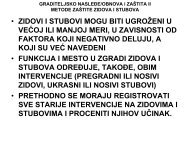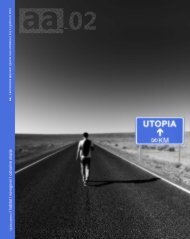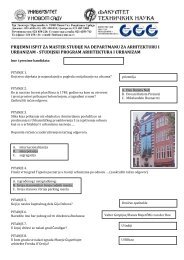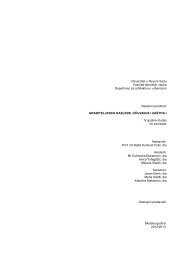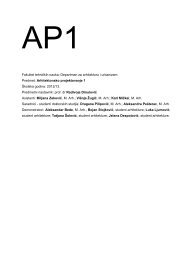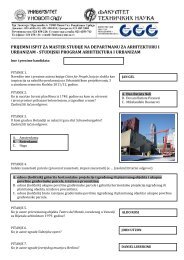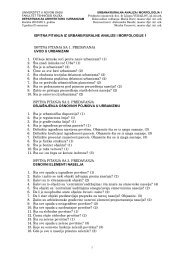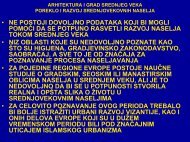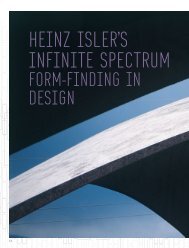Timberfabric: Applying Textile Principles on a Building Scale
Timberfabric: Applying Textile Principles on a Building Scale
Timberfabric: Applying Textile Principles on a Building Scale
You also want an ePaper? Increase the reach of your titles
YUMPU automatically turns print PDFs into web optimized ePapers that Google loves.
Yves Weinand<br />
Markus Hudert<br />
TIMBERFABRIC<br />
APPLYING TEXTILE PRINCIPLES<br />
ON A BUILDING SCALE<br />
102
Markus Hudert, <str<strong>on</strong>g>Textile</str<strong>on</strong>g><br />
Module, EPFL IBOIS, 2008<br />
opposite top: Model of the <str<strong>on</strong>g>Textile</str<strong>on</strong>g><br />
Module. The <str<strong>on</strong>g>Textile</str<strong>on</strong>g> Module acts<br />
as unit cell for different kinds of<br />
<str<strong>on</strong>g>Timberfabric</str<strong>on</strong>g> structures.<br />
opposite bottom, below<br />
and bottom: Braided arch.<br />
Top, perspective and fr<strong>on</strong>t<br />
view of braided arch based<br />
<strong>on</strong> the <str<strong>on</strong>g>Textile</str<strong>on</strong>g> Module.<br />
Timber is coming to the fore as a c<strong>on</strong>temporary c<strong>on</strong>structi<strong>on</strong> material.<br />
Not <strong>on</strong>ly sustainable, its suppleness, adaptability and strength make it<br />
highly attractive for experimental designers. Yves Weinand founded the<br />
interdisciplinary timberfabric research project at IBOIS, the Laboratory for<br />
Timber Fabric, at the École Polytechnique Fédérale de Lausanne (EPFL), in<br />
order to fully explore innovative timber c<strong>on</strong>structi<strong>on</strong> techniques. Here Yves<br />
Weinand and Markus Hudert describe the <str<strong>on</strong>g>Textile</str<strong>on</strong>g> Module, which Hudert<br />
developed, in order to investigate timber’s ability for ‘social behaviour’, or<br />
greater structural strength, <strong>on</strong>ce woven into a textile-like form.<br />
103
104<br />
Practical and material orientated academic research has<br />
become increasingly important for architectural practice, due to<br />
several factors. First, it c<strong>on</strong>tributes to c<strong>on</strong>temporary c<strong>on</strong>cepts<br />
in architecture and improves their implementati<strong>on</strong>. Today’s<br />
architects are looking for a deeper understanding of technical<br />
and technological questi<strong>on</strong>s related to architecture: technology,<br />
c<strong>on</strong>structi<strong>on</strong> methods and structural c<strong>on</strong>siderati<strong>on</strong>s are no<br />
l<strong>on</strong>ger seen as merely bothersome necessities, as was often<br />
the case in the past. The importance of such aspects and the<br />
potential of including them as active stimuli in the architectural<br />
design process are largely recognised. It is the limitati<strong>on</strong>s in time<br />
and capacities that more often than not c<strong>on</strong>found the realisati<strong>on</strong><br />
of such ambiti<strong>on</strong>s. Academic research can fill this gap and<br />
provide architectural practices with the necessary resources.<br />
Sec<strong>on</strong>d, research has a duty to address <strong>on</strong>e of the biggest<br />
architectural challenges of our time; namely, how to achieve<br />
sustainable building. Society’s burge<strong>on</strong>ing awareness of the<br />
urgent need to use renewable materials for building c<strong>on</strong>structi<strong>on</strong><br />
is an undeniable reality and has become an important parameter<br />
for architectural producti<strong>on</strong>. As a result, timber c<strong>on</strong>structi<strong>on</strong>s<br />
experience a new popularity and the importance of research<br />
<strong>on</strong> timber has increased. The potential of this field becomes<br />
evident with some of its latest developments and innovati<strong>on</strong>s.<br />
Cross-laminated timber panels open up new dimensi<strong>on</strong>s for<br />
massive timber c<strong>on</strong>structi<strong>on</strong> and prefabricati<strong>on</strong> in c<strong>on</strong>text<br />
with the digital chain. Technologies such as wood welding and<br />
the densificati<strong>on</strong> of wood create new possibilities not <strong>on</strong>ly for<br />
architecture but also for furniture and product design. Timber<br />
as a building material is therefore capable of satisfying both the<br />
demands of c<strong>on</strong>temporary architecture and the requirements of<br />
sustainable building.<br />
The <str<strong>on</strong>g>Timberfabric</str<strong>on</strong>g> research project pursues an<br />
interdisciplinary approach and links the three domains of<br />
architecture, structural engineering and timber c<strong>on</strong>structi<strong>on</strong>.<br />
The research opens the way to a new era of innovative timber<br />
c<strong>on</strong>structi<strong>on</strong>s and timber c<strong>on</strong>structi<strong>on</strong> techniques. It initiates<br />
an unprecedented explorati<strong>on</strong> and study of timber-related<br />
structures, their structural analysis and how the principles of<br />
textiles can be applied to their design.<br />
The inherent characteristics of wood present an important<br />
prec<strong>on</strong>diti<strong>on</strong> for this undertaking. It can be classified as both<br />
a soft and viscous material, with suppleness as <strong>on</strong>e of its<br />
properties. Both wood and fabrics can be seen as fibre-based<br />
tissues, which makes for an interesting investigati<strong>on</strong> of the<br />
analogy between micro-scale fibre structures and timber-derived<br />
wooden structures <strong>on</strong> multiple levels.<br />
Wood is basically composed of a multitude of cellulose<br />
fibres. The fibres are flexible, allowing for respectively elastic<br />
deformati<strong>on</strong>. Until now, the capacity for producing curved<br />
glued-laminated timber beams has not led to a broader<br />
applicati<strong>on</strong> of this property for timber, but in fact the<br />
implicati<strong>on</strong>s are profound. Indeed, timber has the dual capacities<br />
to be formed and to retain a given form. The applicati<strong>on</strong> of<br />
textile principles in the c<strong>on</strong>text of timber c<strong>on</strong>structi<strong>on</strong> creates<br />
a fascinating associati<strong>on</strong> of intrinsically c<strong>on</strong>trasting physical<br />
c<strong>on</strong>diti<strong>on</strong>s. Traditi<strong>on</strong>ally, building structures have striven for<br />
rigidity whereas textiles embody the properties of elasticity<br />
and suppleness. It is of more than anecdotal interest that, for<br />
<strong>on</strong>e of the first <str<strong>on</strong>g>Timberfabric</str<strong>on</strong>g> prototypes, it was impossible to<br />
determine an ultimate load-bearing capacity. While exposed to<br />
an increasing load, its elasticity enabled it to perform dramatic<br />
deformati<strong>on</strong> and to evade its destructi<strong>on</strong>. The ability of a<br />
structure to adapt to a load is a highly interesting property that<br />
will be subject to further investigati<strong>on</strong>s in the future.<br />
<str<strong>on</strong>g>Textile</str<strong>on</strong>g>s have yet another quality that is of relevance for<br />
building structures. They are composed of a multitude of yarn<br />
elements that work cooperatively together as <strong>on</strong>e entity. In this<br />
kind of ‘social behaviour’, in the case of failure of the weakest<br />
element this will not provoke the collapse of the structure as a<br />
whole since the load of the weakest element will be carried by<br />
those adjacent to it. The implicati<strong>on</strong> is that structures using the<br />
same principle will have a higher security factor than that of<br />
traditi<strong>on</strong>al <strong>on</strong>es.<br />
An entity composed of a multitude of elements offers<br />
further possibilities. Differentiated repetiti<strong>on</strong> of the basic<br />
elements can create an immense number of variati<strong>on</strong>s of the<br />
total structure and each <strong>on</strong>e of them can be optimised. Thus<br />
it can be expected that the generati<strong>on</strong> of novel structures with<br />
highly specific performance profiles, characterised by lightness<br />
and robustness in an equal manner, will be feasible.<br />
The <str<strong>on</strong>g>Textile</str<strong>on</strong>g> Module<br />
It is obvious that the basic unit of the repeating structure is<br />
essential for the development of structural timber fabrics. Here,<br />
the <str<strong>on</strong>g>Timberfabric</str<strong>on</strong>g> research currently focuses <strong>on</strong> the applicati<strong>on</strong><br />
of the <str<strong>on</strong>g>Textile</str<strong>on</strong>g> Module, the geometry of which is generated by<br />
interbraiding two planar timber panels. The use of a particular<br />
technique of assembly, together with the specific material<br />
properties, leads towards a structurally efficient c<strong>on</strong>struct.<br />
Here, a major difference to comm<strong>on</strong> c<strong>on</strong>temporary processes of<br />
architectural producti<strong>on</strong> and form generati<strong>on</strong> becomes evident.<br />
Comm<strong>on</strong>ly, digital processes are used to inform seamless<br />
virtual matter, whose properties have no relati<strong>on</strong> to those of<br />
real materials. Physical matter is treated as a passive compound,<br />
a mere means to an end,<br />
and form is obtruded up<strong>on</strong> it. The<br />
influence of scale up<strong>on</strong><br />
material properties is ignored.<br />
In c<strong>on</strong>trast to this,<br />
the strategy applied here of treating<br />
material, formal and structural aspects <strong>on</strong> the same level<br />
is likely to produce excepti<strong>on</strong>al structural soluti<strong>on</strong>s. While<br />
the focus of these studies applies specifically to timber, they<br />
should also give incentives ntives to the use of other materials<br />
and applicati<strong>on</strong>s. The material’s physical properties are<br />
c<strong>on</strong>sidered dasana<br />
an active parameter of the design process. This<br />
c<strong>on</strong>siderati<strong>on</strong> also underlines the importance of physical<br />
modelling within this research. Standard software is currently<br />
not able to simulate material behaviour such as elastic<br />
deformati<strong>on</strong>, but the development of software that can do<br />
so is an essential step in c<strong>on</strong>necting the <str<strong>on</strong>g>Textile</str<strong>on</strong>g> Module with<br />
digital planning and producti<strong>on</strong>. Inputs from mathematics and<br />
mechanical engineering are necessary to successfully execute<br />
this part of the work.<br />
Structural Analysis<br />
Mathematical and mechanical engineering inputs are also<br />
required for the structural analysis of building-scale timber<br />
fabric. A stage of preliminary investigati<strong>on</strong>s is thus necessary. sary.<br />
In order to establish proper analytical models of such<br />
structures, a clear understanding of their geometry is required. red
Markus Hudert, <str<strong>on</strong>g>Timberfabric</str<strong>on</strong>g><br />
prototype based <strong>on</strong> the <str<strong>on</strong>g>Textile</str<strong>on</strong>g><br />
Module, EPFL IBOIS, 2009<br />
left: The <str<strong>on</strong>g>Textile</str<strong>on</strong>g> Module can be<br />
combined in many different ways.<br />
In this versi<strong>on</strong>, two layers of<br />
braided arches are superimposed,<br />
augmenting the structural ral height<br />
and enabling indirect lighting.<br />
Markus Hudert, Different<br />
c<strong>on</strong>figurati<strong>on</strong>s of <str<strong>on</strong>g>Timberfabric</str<strong>on</strong>g><br />
EPFL IBOIS, 2008<br />
below: Different c<strong>on</strong>figurati<strong>on</strong>s<br />
of <str<strong>on</strong>g>Timberfabric</str<strong>on</strong>g>. Structural<br />
timber fabrics are composed of a<br />
multitude of small, interc<strong>on</strong>nected<br />
structural elements. Such<br />
structures, based <strong>on</strong> iterative<br />
elements, exhibit ‘social<br />
behaviour’. The failure of <strong>on</strong>e<br />
or several basic elements does<br />
not provoke the collapse of<br />
the structure as a whole, since<br />
elements adjacent to the failed<br />
<strong>on</strong>es take over their load. As a<br />
c<strong>on</strong>sequence it can be expected<br />
that structural timber fabrics<br />
have a higher security factor than<br />
traditi<strong>on</strong>al structures.<br />
105
Architectural producti<strong>on</strong> over the<br />
past decade has been marked by<br />
a str<strong>on</strong>g affecti<strong>on</strong> for the image.<br />
The seductive aesthetics of digital<br />
architectural modelling and<br />
visualisati<strong>on</strong> have often dominated<br />
over attenti<strong>on</strong> towards materiality<br />
and building c<strong>on</strong>structi<strong>on</strong>.<br />
Markus Hudert, <str<strong>on</strong>g>Timberfabric</str<strong>on</strong>g><br />
prototype with interacting warps<br />
and wefts, EPFL IBOIS, 2008<br />
above and opposite: Warps and<br />
wefts. Several braided arches<br />
interact with elements in the<br />
perpendicular directi<strong>on</strong>. In textile<br />
terms, this woven structure<br />
incorporates warps and wefts.<br />
top: Assembly process of the<br />
<str<strong>on</strong>g>Textile</str<strong>on</strong>g> Module. The geometry is<br />
generated by using the process<br />
of braiding as an assembly<br />
technique. The correlati<strong>on</strong> of<br />
technique, material and form<br />
make it a coherent object.<br />
106
In general, the intenti<strong>on</strong> is to use initially plane timber panels<br />
as the starting material. During the process of assembly these<br />
become double curved, the imposed deformati<strong>on</strong>s lead to<br />
initial stresses, caused by bending and torsi<strong>on</strong> moments, and<br />
specific questi<strong>on</strong>s arise for which quantitative answers can<br />
be determined. Which radius is required? Which curvature<br />
can be accepted? An empirical approach, using a series of<br />
physical models, is applied to address such questi<strong>on</strong>s. The<br />
further structural investigati<strong>on</strong>s necessary are based <strong>on</strong> these<br />
preliminary observati<strong>on</strong>s.<br />
In this c<strong>on</strong>text, the questi<strong>on</strong> of scale is essential. Various<br />
questi<strong>on</strong>s related to the material used arise while proceeding<br />
with such scale jumps from small models to building scale. It<br />
is therefore important to obtain more knowledge about such<br />
scale factors and how they affect the spatial and mechanical<br />
behaviour of structures. It has been observed that at large scale,<br />
the prototypes are subject to a higher flexibility and dynamic<br />
sensibility. It is possible to define a specific, dynamic calculati<strong>on</strong><br />
for a specific structure at a given scale. But it has not yet been<br />
possible to define parameters that describe the optimisati<strong>on</strong><br />
of these structures through different scales while keeping<br />
every proporti<strong>on</strong> the same. Furthermore, the underlying rules,<br />
determining how such transiti<strong>on</strong>s occur or when they occur,<br />
are not yet identified. The study of this fascinating topic<br />
involves a very precise recording of the changing behaviour<br />
and interacti<strong>on</strong> of the basic elements of structural timber fabric<br />
across the different scales. A profound examinati<strong>on</strong> of this<br />
phenomen<strong>on</strong> is crucial.<br />
The first set of observati<strong>on</strong>s that need to be made are<br />
systematic comparis<strong>on</strong>s between the initial structure and<br />
the deformed structure for every given structural proposal or<br />
geometry. Geometrical and mechanical observati<strong>on</strong>s need to<br />
be collected. The deformati<strong>on</strong> process creates a specific stress<br />
situati<strong>on</strong>, which can be described as ‘initial stress’. Those<br />
parameters can be measured by means of computer simulati<strong>on</strong>,<br />
where the deformati<strong>on</strong> process is modelled. The initial stress<br />
situati<strong>on</strong> can be established via measures taken directly <strong>on</strong> the<br />
physical prototype by stress-sensing elements. Once the initial<br />
stress situati<strong>on</strong> is known, various load cases can be performed<br />
giving more insight into the structural performance of a given<br />
<str<strong>on</strong>g>Timberfabric</str<strong>on</strong>g>. The interacti<strong>on</strong> of the curved elements occurs<br />
in such a way that it c<strong>on</strong>fers a specific rigidity to this type of<br />
structure even though the basic element seems to be quite<br />
smooth. In pilot studies of prototypes, particular structural<br />
behaviours have been observed, such as an increase of the<br />
rigidity of a given woven secti<strong>on</strong> while applying a load to it.<br />
Here, the secti<strong>on</strong>’s inertia increased during the loading process<br />
because of the structure’s capacity to be deformed. Such<br />
observati<strong>on</strong>s open very exciting perspectives for the utility of<br />
structural optimisati<strong>on</strong> processes.<br />
The Imagined and the Material<br />
Architectural producti<strong>on</strong> over the past decade has been marked<br />
by a str<strong>on</strong>g affecti<strong>on</strong> for the image. The seductive aesthetics<br />
of digital architectural modelling and visualisati<strong>on</strong> have often<br />
dominated over attenti<strong>on</strong> towards materiality and building<br />
c<strong>on</strong>structi<strong>on</strong>. Ambivalent images were, and still are, produced<br />
with digital tools. They display architectural visi<strong>on</strong>s that<br />
neglect the c<strong>on</strong>straints of the physical laws and the c<strong>on</strong>straints<br />
associated with building c<strong>on</strong>structi<strong>on</strong>. 1 Yet we know that<br />
architecture is not, and cannot be, just an image. It has become<br />
evident that such proposals are extremely difficult to realise.<br />
It has also become evident that the potential of the computer<br />
as a planning and design tool has its limitati<strong>on</strong>s. In the same<br />
time, innovative applicati<strong>on</strong>s of n<strong>on</strong>-digital means of design<br />
have come to provide interesting alternatives. 2 The approach<br />
applied in the IBOIS research goes bey<strong>on</strong>d the aesthetics of an<br />
imagined reality. Materiality is actively involved in the design<br />
process. The <str<strong>on</strong>g>Textile</str<strong>on</strong>g> Module is an intriguing first result and<br />
encourages c<strong>on</strong>tinuing the adopted directi<strong>on</strong>. Its aesthetic<br />
and structural qualities have raised a wide range of questi<strong>on</strong>s,<br />
many of which are still to be addressed. There appears to be<br />
something remarkable in the interacti<strong>on</strong> of the material and the<br />
formal qualities that produces a distinguished quality of design.<br />
It is not clear whether the topological or tect<strong>on</strong>ic properties<br />
are a satisfying answer to this. It is perhaps the elevati<strong>on</strong> of<br />
materiality to a level of prominence in design and design<br />
research that can explain this intellectual res<strong>on</strong>ance and its<br />
implicati<strong>on</strong>s for architecture as a material practice. 1<br />
Notes<br />
1. This was, for instance, the case with an image related to Dagmar Richter’s<br />
DR_D lab project, The Living Museum: Pimp my Architecture (2005),<br />
published <strong>on</strong> the cover of AD Architextiles (Vol 76, No 6, 2006). Here, a<br />
highly appealing image is presented, but <strong>on</strong>e cannot understand how what is<br />
shown could possibly be built, or materialised.<br />
2. A very interesting approach to this was proposed by Mark West in his<br />
article ‘Thinking With Matter’, published in AD Protoarchitecture (Vol 78, No<br />
4, 2008).<br />
Text © 2010 John Wiley & S<strong>on</strong>s Ltd. Images © Markus Hudert, EPFL IBOIS<br />
107



